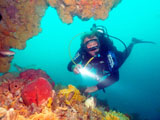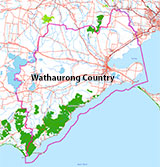Lonsdale Wall Boat Dive 01-03-25
Lonsdale Wall
![]() Wall Dive |
Wall Dive | ![]() Boat access
Boat access
![]()
![]()
![]()
![]()
![]()
![]()
![]()
![]()
Depth: 12 m (39 ft) to 38 m (125 ft)
The Lonsdale Wall dive site is but one of the many spectacular dive sites on Lonsdale Wall. The tidal flow in and out of Port Phillip each day means this site is in high-velocity waters providing plenty of nutrients for the marine life that densely covers Lonsdale Wall. Thus this site should be dived on the short window of slack water. Dive charter boats operating out of Portsea and Queenscliff regularly schedule this dive site, or one of the other dive sites on Lonsdale Wall. Private dive boats usually head out to Lonsdale Wall from the Sorrento or Queenscliff boat ramps.
The Swim Through, by Jane Headley.

Tom Wende diving Lonsdale Wall
© Sonar Wetsuits
Lonsdale Wall has overhangs and ledges and undercuts providing sanctuary to an enormous variety of fish including the spectacular Southern Blue Devil, Leather Jackets, Dusky Morwong, Southern Hulafish, Old Wives plus Southern Rock Lobster (aka Crayfish) and Giant Australian Cuttlefish. Occasional sightings of a Port Jackson Shark snoozing under a ledge, or and if you are really lucky you may even spot a Gulf Wobbegong or Sharpnose Sevengill Shark cruising slowly along the wall. Colourful growth in the form of soft corals, sponges, hanging sea fans in bright yellow, orange and other varieties in pink and burgundy. At least four different species of Nudibranchs and Seastars can be found here if you look closely.
As you descend down Lonsdale Wall there is a slight step out every 6 to 9 metres or so, and behind each step-out, there is a huge overhang. Shining a torch under these ledges will reveal a myriad of life and colour, with sections carpeted in Yellow Zoanthid Anemone like a field of yellow daisies.
Divers need to be careful as they descend on Lonsdale Wall. The next terrace down may appear not so far, but before you know it, you can be unintentionally in very deep water. Because of the strong currents caused by fast tidal flow near The Heads, Lonsdale Wall is dived on slack water. Dives are usually limited to 20 to 30 minutes of slack water. Slack water is halfway between high and low water.
Lonsdale Wall from Allie Beckhurst on Vimeo.
Dive charter boats regularly schedule dives on Lonsdale Wall, heading out from Portsea and Queenscliff. Private dive boats usually launch at the Sorrento Boat Ramp or the Queenscliff Boat Ramp.
The Rip & Tides Warning: Always keep an eye on sea conditions throughout any shore or boat dive within "The Rip" (aka "The Heads"). This is a dangerous stretch of water, where Bass Straight meets Port Phillip, which has claimed many ships and lives. Please read the warnings on the web page diving-the-rip before diving or snorkelling this site.
Lonsdale Wall
This dive site is one of many on Lonsdale Wall, located just inside The Heads on the Lonsdale side of Port Philip — one of Australia's premier dive locations. Lonsdale Wall is one side of an underwater canyon formed by the old Yarra River as it flowed out to sea through the plains, carving steep-walled edges out of soft rock sides. Between the end of the last Ice Age around 8000 BCE and around 6000 BCE, the sea-level rose to drown what was then the lower reaches of the Yarra River. Thus the canyon formed by the river near what is now The Heads, or The Rip, was flooded creating the Lonsdale Wall, North Wall and Nepean Wall areas. Lonsdale Wall extends for one kilometre, providing many spectacular dive sites. An almost vertical drop characterises Lonsdale Wall with the wall starting as shallow as 8 m (26 ft) metres deep in places and sometimes dropping down to well over 60 m (197 ft) deep. See also, Port of Melbourne Rip Map — Oblique seabed image of The Heads produced by hydrographic surveys.

Wathaurong (Wadda-Warrung) country
Traditional Owners — This dive site is in the traditional Country of the Wathaurong (Wadda-Warrung) people of the Kulin Nation. This truly ancient Country includes the coastline of Port Phillip, from the Werribee River in the north-east, the Bellarine Peninsula, and down to Cape Otway in the south-west. We wish to acknowledge the Wathaurong as Traditional Owners. We pay respect to their Ancestors and their Elders, past, present and emerging. We acknowledge Bunjil the Creator Spirit of this beautiful land, who travels as an eagle, and Waarn, who protects the waterways and travels as a crow, and thank them for continuing to watch over this Country today and beyond.
Availability: Contact us for booking information



